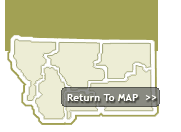

| Home | Communities | Accommodations | Places To Go | Things To Do | Site Map |
|
Glacier Country
Central Montana
Missouri River Country
Southwest Montana
Yellowstone Country
Southeast Montana
|

Ninepipe and Pablo National Wildlife RefugeRonan MontanaListing Type: Wildlife Management AreaCity: Ronan Montana Region: Glacier Country 406-644-2211 http://mountain-prairie.fws.gov/refuges/ninepipe/ninepipe.htm |  More Images |
This exceptional wetland complex contains over 800 glacial potholes and a 1,770-acre reservoir. About 200 bird species have been recorded. A jointly managed viewing area is just off US Highway 93 on the east side of the reservoir, about 0.75 mile south of the junction with Secondary Route 212. An access road and paved trail provide for waterfowl and shorebird viewing; the trail is barrier-free. Nesting great blue herons and double-crested cormorants can be observed from the road on the west side of the refuge. Follow SR 212 along the north shore for 2 miles to the dike entrance to view ducks, grebes, and short-eared owls. Duck Road offers viewing of pothole ponds for about 2 miles: to reach it, turn west off US 93, 1 mile north of SR 212. Superb viewing of raptors in winter.
Hunting opportunities: Both refuges are closed to hunting. Adjoining State-owned lands are managed by the Montana Department of Fish, Wildlife and Parks for wildlife cover, food production, and public hunting. These lands are open to hunting on a first-come-first-served basis for waterfowl and pheasant shooting. The closure of Ninepipe and Pablo enhances the quality of hunting in the Flathead Valley. Providing a sanctuary keeps more birds in the area for a longer period of time. In addition, the Fish and Wildlife Service administers a number of Waterfowl Production Areas nearby which are open to public hunting.
Excellent pheasant and waterfowl hunting is available. A joint state/tribal license and a Flathead Reservation bird stamp are required of all hunters who are not members of the Confederated Salish and Kootenai Tribes. A federal migratory waterfowl stamp is required to hunt waterfowl. Regulations are formulated by the Flathead Reservation Fish and Wildlife Advisory Board and approved by the Tribal Council and Montana Fish, Wildlife & Parks Commission.
Fishing is allowed on both refuges in accordance with applicable State and Tribal regulations. Yellow perch and largemouth bass at Ninepipe, and rainbow trout at Pablo often furnish excellent fishing. Ice fishing is permitted after the waterfowl hunting season has ended. Boats or floatation devices are not permitted on either reservoir and a tribal recreation permit is required. . .Wildlife viewing: Opportunities abound for viewing songbirds, upland game birds, and waterfowl, especially in spring. Winter raptor viewing is nationally acclaimed. Numerous mammal and reptile species are commonly seen. A wildlife viewing and interpretative site with special features for people with disabilities has recently been added.
Directions: Ninepipe Reservoir is located in northwest Montana near Ronan. From Ronan (45 miles north of Missoula), go south on US Highway 93 for 4 miles and watch for refuge, Waterfowl Production Area, and Wildlife Management Area signs. The area lies on both sides of Highways 93 and 212, and is criss-crossed by several county roads. Signed parking areas are located along many of the roads.
Ninepipe and Pablo National Wildlife Refuge
132 Bison Range Road, Moiese, MT 59824
|
A source for Montana Travel & Tourism Information
![]()